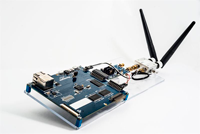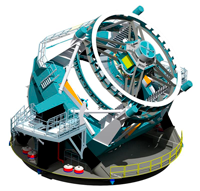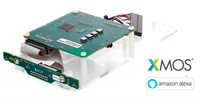Electronics News
Archive : 15 October 2017 год
 As part of the CarriCool project, Fraunhofer researchers have worked with IBM to develop what is said to be an effective method for cooling processors. According to the team, by integrating microchannels into the silicon interposer, a significant increase in performance can be achieved. Meanwhile, the team has also integrated passive components for voltage regulators, photonic ICs and optical waveguides into the interposer.
As part of the CarriCool project, Fraunhofer researchers have worked with IBM to develop what is said to be an effective method for cooling processors. According to the team, by integrating microchannels into the silicon interposer, a significant increase in performance can be achieved. Meanwhile, the team has also integrated passive components for voltage regulators, photonic ICs and optical waveguides into the interposer.
The team, from Fraunhofer’s Institute for Reliability and Microintegration (IZM) in Berlin and Dresden developed an interposer with microchannel structures and hermetically sealed vias. The structure allows coolant to be pumped through the microchannels, channelling heat away from the processor.
“Until now, the cooling structures have not been very close to the computer core itself, which means the coolers are mostly applied from above,” says Dr Hermann Oppermann, group leader at Fraunhofer IZM. “The closer you get to the heat source, the better the temperature can be limited or the output increased. In high performance computing in particular, data rates are increasing continuously. Therefore, it is important to have effective cooling in order to ensure a higher clock rate. Previous cooling systems were not so effective in this context. With this new cooling system, performance can be increased significantly.”
The challenge was not only to integrate the small channels into the interposer, but also to seal them hermetically. The solution is an interposer featuring horizontal cooling channels and vertical channels for the electrical connections. In order to prevent contact between the water and the electrical vias, each individual contact is specially sealed.
The researchers also integrated voltage regulators for the power supply, as well as optoelectronic components for data transmission into the interposer. “By combining interposer, cooling, voltage regulators and optical interconnection technology, we have reached a new level of integration that allows smaller circuits with more power,” said Dr Oppermann. “This is an important step in high-performance computing, as we achieve higher clock speeds in the same amount of space.”
Author
Graham Pitcher
Source: www.newelectronics.co.uk
 Belgian research centre imec is to work with Analog Devices to develop the next generation of IoT devices. The move, building on two existing initiatives, is intended to produce devices that are not only low-power, but which also feature largely improved or completely new sensing capabilities.
Belgian research centre imec is to work with Analog Devices to develop the next generation of IoT devices. The move, building on two existing initiatives, is intended to produce devices that are not only low-power, but which also feature largely improved or completely new sensing capabilities.
One joint research initiative already underway focuses on localisation technology. A second initiative includes the creation and commercialisation of a highly-integrated liquid sensor that can be used in a variety of application domains, such as the analysis of water, blood or urine.
“Building on imec’s world-leading position in innovative ultra-low power implementations, ADI and imec will pursue the development of a low-power sensor for highly accurate indoor localiSation in the context of smart building or smart industry solutions,” said imec programme director Kathleen Philips. “We want this sensor to … achieve up to five times better accuracy than today’s best-performing solutions.”
Peter Real, Analog Devices’ CTO, added: “We have chosen to take our collaboration with imec to the next level because its expertise in each of those domains – and its position at the crossroads of both the scientific and industrial communities – is fundamental to helping us successfully develop the next generation of IoT sensors.”
Author
Graham Pitcher
Source: www.newelectronics.co.uk
 Teledyne e2v has been awarded a multimillion dollar contract by SLAC National Accelerator Laboratory (SLAC) to supply customised Charge Coupled Device (CCD) image sensors for the Large Synoptic Survey Telescope.
Teledyne e2v has been awarded a multimillion dollar contract by SLAC National Accelerator Laboratory (SLAC) to supply customised Charge Coupled Device (CCD) image sensors for the Large Synoptic Survey Telescope.
The 8.4 metre telescope is being constructed in Chile to carry out a ten-year survey of the sky to address a range of fundamental astronomy questions about dark matter, dark energy, near Earth asteroids, transient optical objects (such as supernovae), and the formation of our Milky Way galaxy.
Teledyne e2v has designed a high-performance customised sensor capable of providing exceptional sensitivity and stable performance with an extremely flat focal surface which delivers 3,200 Megapixels of image data per exposure.
The camera will incorporate 189 large-area sensors which will be delivered to SLAC for construction into the cryogenically-cooled camera. Approximately one third of the science sensors have already been delivered in a previous contract phase. The contract award follows previous prototype and 'First Article' contracts and requires Teledyne e2v to deliver essential components for the LSST.
The LSST, identified as a US national scientific priority by the 2010 USA National Research Council decadal survey, has the largest digital camera ever built for ground-based astronomy and will be one of the world’s most powerful astronomical survey telescopes when commissioned in 2021. The telescope has a novel three-mirror design to provide high efficiency and a wide field of view.
SLAC is building the camera which will record images that cover an area of 49 times that of a full moon. The powerful telescope will capture images of the entire sky every few nights in multiple colour bands. These will be used to construct a detailed catalogue of the sky, providing brightness, colour and time variability information at a greater depth than ever before.
“This telescope and camera will stimulate the astronomy world with a huge survey data set which will be followed by many astronomers worldwide and will set a new standard against which other instruments will be compared,” said Dr. Paul Jorden, Astronomy Product Specialist at Teledyne e2v. The sensors have very challenging design features and Teledyne e2v has been able to demonstrate that they can be manufactured in large quantities and delivered to a tight schedule.
The sensors supplied by Teledyne e2v will be at the very heart of the LSST camera. They have been designed for very high sensitivity and optimised for enhanced red wavelength sensitivity. The large camera requires an extremely flat focal surface, and so the Teledyne e2v sensors are designed to achieve a surface flatness precision one-twentieth of the width of a human hair.
The 189 sensors will be built in a custom package that enables all of them to be assembled into a closely-packed mosaic to form the three Gigapixel array with minimal lost area and a mere 0.25 mm gap between sensors across the 630mm diameter focal plane.
The sensors have 16 output channels that enable them to read the image in a few seconds and allow a high rate of image collection.
Author
Neil Tyler
Source: www.newelectronics.co.uk
 XMOS has announced the launch of the VocalFusion 4-Mic Dev Kit for the Amazon Alexa Voice Service (AVS).
XMOS has announced the launch of the VocalFusion 4-Mic Dev Kit for the Amazon Alexa Voice Service (AVS).
Said to be the first far-field linear mic array solution available on the market, the kit has been designed for developers who are looking to integrate Alexa into smart panels, kitchen appliances, and other commercial and industrial electronics.
The kit comprises of a compact four-microphone linear 100mm array. The captured voice signals are extremely clear even in noisy environments, enabling commands to be accurately captured from across the room for processing by the Alexa cloud-based speech recognition system.
According to XMOS this is the only solution to date that combines audio digital signal processing (DSP) and programmable I/O processing and control software into a single chip, enabling customers to significantly reduce their bill of materials, tailor their designs, and reduce costs.
The VocalFusion 4-Mic Dev Kit is the first development kit to feature a reference client built using the recently released AVS Device SDK. The AVS Device SDK is designed to simplify creating Alexa-enabled products, helping commercial device makers get AVS products to market faster.
Commenting Priya Abani, Director, Amazon Alexa said, “XMOS’ VocalFusion 4-Mic Dev Kit for Amazon AVS will accelerate the deployment of Alexa in deeply embedded systems, new device types, and form-factors, bringing customers more choice of where to access Alexa.”
At its heart the VocalFusion XVF3000, has a highly integrated far-field voice processor based on the XMOS xCORE multicore architecture. The XVF3000 delivers sophisticated voice DSP capability including a full duplex acoustic echo canceller (AEC) with barge-in capability that enables users to interrupt or pause a device that’s playing music, and sophisticated noise suppression with adaptive beamforming to provide high quality voice interaction experiences even in noisy environments.
According to Mark Lippett, President and CEO at XMOS, “Solutions like ours will enable developers to bring to market connected products that can be used with simplicity, in our own natural spoken language. We are working with our partners to accelerate the adoption of AVS as the voice solution of choice for the Internet of Things.”
The VocalFusion 4-Mic Kit for Amazon AVS (XK-VF3000-L33-AVS) is immediately available to developers, OEMs, and ODMs from Digi-Key.
Author
Neil Tyler
Source: www.newelectronics.co.uk
